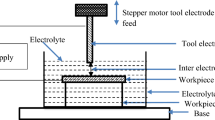Abstract
Electrochemical machining (ECM) process has unique capabilities to offer a better alternative and sometimes is considered the only available option to cut or create intricate profiles into hard materials. ECM is a mirror-shaped-process; i.e., the shape developed into the workpiece is a mirror image to the tool profile. This study presents an application of using copper wire as a tool to create peripheral grooves. This method saves time and cost of profiling the cathode as a mirror image of the predetermined workpiece shape. This article discusses the influences of input parameters—wire feed rate, wire diameter, and workpiece rotational speed—on the responses, frontal gap, metal removal rate, specific power consumption, and groove geometry, using response surface methodology (RSM). Mathematical models were developed for the aforementioned responses, and their adequacies were checked using analysis of variance (ANOVA). The process could be optimized to create predetermined groove with a specific width; for example, the optimum values of feed rate, wire diameter, and workpiece speed are 0.07 mm/min, 2.3 mm, and 450 rpm, respectively, to maximize the MRR and minimize the specific power consumption in order to create a groove of 9.4 mm in width.
Similar content being viewed by others
References
Burger M et al (2012) Electrochemical machining characteristics and resulting surface quality of the nickel-base single-crystalline material LEK94. J Manuf Process 14(1):62–70
Rao SR et al (2014) Parametric study for radial over cut in electrochemical drilling of Al-5%B4Cp composites. Procedia Eng 97:1004–1011
Kulkarni A, Sharan R, Lal GK (2002) An experimental study of discharge mechanism in electrochemical discharge machining. Int J Mach Tools Manuf 42(10):1121–1127
Basak I, Ghosh A (1997) Mechanism of material removal in electrochemical discharge machining: a theoretical model and experimental verification. J Mater Process Technol 71(3):350–359
Basak I, Ghosh A (1996) Mechanism of spark generation during electrochemical discharge machining: a theoretical model and experimental verification. J Mater Process Technol 62(1–3):46–53
Bhattacharyya B, Doloi BN, Sorkhel SK (1999) Experimental investigations into electrochemical discharge machining (ECDM) of non-conductive ceramic materials. J Mater Process Technol 95(1–3):145–154
Chen X et al (2015) Reduction of undercutting in electrochemical micro-machining of micro-dimple arrays by utilizing oxygen produced at the anode. Surf Coat Technol 277:44–51
Klocke F, Zeis M, Klink A (2015) Interdisciplinary modelling of the electrochemical machining process for engine blades. CIRP Ann Manuf Technol 64(1):217–220
Lohrengel MM, Rataj KP, Münninghoff T (2016) Electrochemical machining—mechanisms of anodic dissolution. Electrochim Acta. doi:10.1016/j.electacta.2015.12.219
El-Hofy HAG (2013) Fundamentals of machining processes: conventional and nonconventional processes, 2nd edn. Taylor & Francis, Boca Raton
Béjar MA, Eterovich F (1995) Wire-electrochemical cutting with a NaNO3 electrolyte. J Mater Process Technol 55(3–4):417–420
Neto JCS, Silva EM, Silva MB (2006) Intervening variables in electrochemical machining. J Mater Process Technol 179(1–3):92–96
Lohrengel MM (2005) Pulsed electrochemical machining of iron in NaNO3: fundamentals and new aspects. Mater Manuf Process 20(1):1–8
Yonghua L, Dongbiao Z, Kai L (2013) Experimental investigation of a new grid cathode design method in electrochemical machining. J Manuf Sci Eng 135(2):024503–024503
Zhu D, Wang K, Qu NS (2007) Micro wire electrochemical cutting by using in situ fabricated wire electrode. CIRP Ann Manuf Technol 56(1):241–244
Qu N et al (2013) Wire electrochemical machining with axial electrolyte flushing for titanium alloy. Chin J Aeronaut 26(1):224–229
El-Taweel TA, Gouda SA (2010) Performance analysis of wire electrochemical turning process—RSM approach. Int J Adv Manuf Technol 53(1):181–190
Bezerra MA et al (2008) Response surface methodology (RSM) as a tool for optimization in analytical chemistry. Talanta 76(5):965–977
Khuri AI, Mukhopadhyay S (2010) Response surface methodology. Wiley Interdiscip Rev 2(2):128–149
Jones R (2002) Design and analysis of experiments (fifth edition). Douglas Montgomery, Wiley, 2001, 684 pages, £33.95. Quality and Reliability Engineering International 18(2):163–163
Liu WD et al (2016) Elimination of the over cut from a repaired turbine blade tip post-machined by electrochemical machining. J Mater Process Technol 231:27–37
Tiwari A, Mandal A, Kumar K (2015) Optimization of overcut in electrochemical machining for EN 19 tool steel using Taguchi approach. Mater Today 2(4–5):2337–2345
Dietz H et al (1979) Electrochemical turning, considerations on machining rates which can be attained. Ann CIRP 28:93–97
El-Taweel TA, Gouda SA (2010) Study on the wire electrochemical groove turning process. J Appl Electrochem 41(2):161–171
Derringer G, Suich R (1980) Simultaneous optimization of several response variables. J Qual Technol 12(4):214–219
Ferreira SLC et al (2007) Box-Behnken design: an alternative for the optimization of analytical methods. Anal Chim Acta 597(2):179–186
Costa NR, Lourenço J, Pereira ZL (2011) Desirability function approach: a review and performance evaluation in adverse conditions. Chemom Intell Lab Syst 107(2):234–244
Author information
Authors and Affiliations
Corresponding author
Electronic supplementary material
Below is the link to the electronic supplementary material.
ESM 1
(DOCX 32 kb)
Rights and permissions
About this article
Cite this article
Araby, S., Zaied, R., Haridy, S. et al. Grooves into cylindrical shapes by wire electrochemical machining. Int J Adv Manuf Technol 90, 445–455 (2017). https://doi.org/10.1007/s00170-016-9389-3
Received:
Accepted:
Published:
Issue Date:
DOI: https://doi.org/10.1007/s00170-016-9389-3




